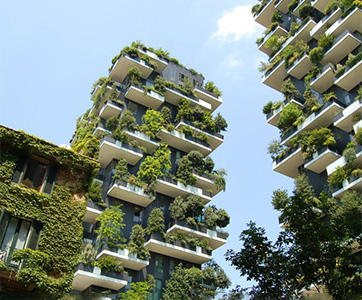

Biophilia, living with nature
By Faezeh Abadi
“Man, as a living organism, needs innate connection with nature. Today’s urban life style, which is very far from nature, is contrary to this natural need of humans… The connection and dependency of humans with nature is unbreakable.
Adapted from “Biophilia” written by Edward O. Wilson, 1984.
Following the industrial revolution and increase in migration to cities in the last century, we have witnessed excessive growth and expansion in urban communities, especially Asian cities. Changes in natural landscape and atmospheric conditions, the quality of runoff and underground water resources, flood cycle and the creation of environmental hazards, soil erosion, acid rains etc. are examples of urbanization impact on the environment. These unfavorable conditions forced city planners and theorists to redesign and pay attention to the environmental dimensions of cities. Theorist such as Howard, Wright and Le Corbusier sought to bring changes in communities and urban environment, and Howard’s city garden was an example of these efforts to heal psychological and environmental damage of industrialized societies.
Among them, the theory of ecological city and school of specialized idealism, later on writings of Louis Mumford and Jane Jacobs and design with nature by Ian McHarg, were the initial manifestations of attempt to form green urbanism, however none of them clearly used term green urbanism. The emergence of concepts such as green and environment-friendly urban planning and architecture, carbon neutral design, and compilation of green building design indicators such as LEED and HQE are efforts in this direction.
Biophilia literally means desire toward living systems around us, which was first proposed by Eric Fromm, and Wilson gave it more credit and defined it as spiritual-instinctive connection of humans to other living beings, which is inherited and part of our nature. The idea of biophilic cities is derived from the theory of biophilia and states that humans have an innate desire to connect with nature and other forms of life. Therefore, a biophilic city consists of micro and macro nature that is felt in citizen’s work, play, residence and daily life. In such a city, people do not need to leave city to have fun and use nature, but nature is included in the context of people’s everyday life. Timothy Beatley in his book Biophilic Cities, emphasized the necessity of using green spaces and parks, roof gardens, green facades and “urban nature” in today’s cities.
In a biophilic city, nature is abundant and a priority in urban designing, planning, and management and recognizes the need for daily connection with nature as important as economic and environmental values. Unfortunately, what we see as urbanization today is conquering and overcoming nature instead of coexisting with it, and people are somehow confused about the role of nature in their mental and physical lives. The disconnection of human with nature, spending time in air-tight areas, and the lack of urban green spaces and parks, posed serious health problems such as: Nature Deficit Disorder, especially in children, Sick Building Syndrome, respiratory problems due to inadequate air ventilation in buildings, vitamin D deficiency due to not receiving enough light, obesity and vascular diseases caused by inactivity for city dwellers.
To conclude Biophilic design seeks to establish a bridge between the inherent need for nature in the modern world and human, which can also serve to the health, well-being and welfare of citizens.
